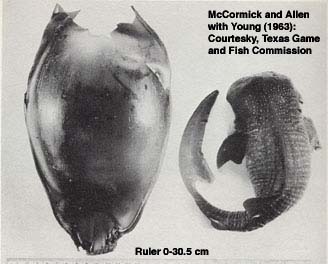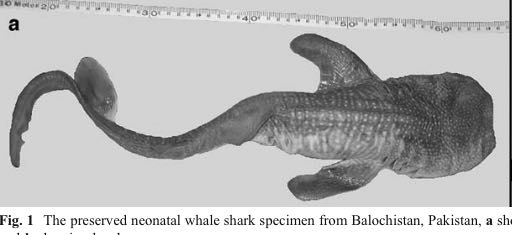
![]()
Garrick (1964)
(download as pdf)
3 size classes


http://seawayblog.blogspot.com/2009/03/smallest-whale-shark-ever-found.html
Above URL gave TL = 38 cm but Aca and Schmidt (2011) reported TL = 46 cm.
Litters and Neonates of Whale Shark Rhincodon typus Smith, 1828 |
|
|
| Photograph | Litter size | TL embryo* (cm) | Mass embryo* (kg) | TL fem. (m) | M fem. (kg) | Capture date | Capture location | Reference |
|---|---|---|---|---|---|---|---|---|
| Female had 16 eggcases in one of her oviducts | 1910 | Ceylon | McCormick and Allen with Young (1963) | |||||
 |
see below | see below | see below | see below | McCormick and Allen with Young (1963) | |||
|
|
35 | embryo was inside 30x14x9 cm eggcase | 29 Jun 1953 | Gulf of Mexico, eggcase trawled from 57 m | Garrick 1964; Compagno
1984; |
|||
| Compagno 1984: "In 1953 a large eggcase, 30 cm long, 14 cm wide, and 9 cm thick containing a nearly full-term 35 cm embryo whale shark was collected from the Gulf of Mexico, and the assumption was made that the species is oviparous (Baughman 1955; Garrick 1964; Bass et al. 1975). However, the rarity of 'free-living' whale shark eggs, the extreme thinness and lack of tendrils on the only known case, the considerable yolk and partially developed gill sieve in the only known embryo, and the presence of umbilcal scars on larger free living specimens 55 cm long suggest the whale shark is ovoviviparous." | ||||||||
| 300 | 42-64, 3 size classes |
1 kg for 0.58 cm embryo | 10 | 16000 | 15 July 1995 | Off Tong Ho on east coast of Taiwan | Joung et al. 1996 (AES abstract). A recently harpooned pregnant female contained about 300 embryos in the uteri. About 15 of the pups were alive and put into containers with sea water. Only 2 could be kept alive, one in Japan, the other in Taiwan. Sex ratio of 237 embryos was 123:114. | |
 |
58.6 | ? | Feb 2006 | 25°02′′N, 64°55′′E, about 10 km offshore of the Ormara headland, on the Balochistan coast, Pakistan | Rowat et al. (2007): The 2 neonates had been caught in 2000 in fishing nets off of Ormara, Pakistan. The pup preserved was a 58.6 cm TL male (Fig. 1a). The sharks were captured by gill nets fishing in the top 100 m in an area of more than 200 m depth. | |||
| Abstract Schmidt et al. (2010): A 10.6 m female whale shark Rhincodon typus caught off the coast of eastern Taiwan in 1995 carried 304 embryos that ranged in developmental stage from individuals still in egg cases to hatched and free-swimming near-term animals. This litter established that whale sharks develop by aplacental yolk-sac viviparity, with embryos hatching from eggs within the female. The range of developmental stages in this litter suggested ongoing fertilization over an extended period of time, with embryos of different ages possibly sired by different males. A series of 9 microsatellite markers for R. typus have now been used to investigate paternity in a subset of these embryos. We determined the paternity of 29 embryos representing 10% of the original litter, and spanning most of the range of size and developmental stage of the 304 embryos. All were full siblings sired by the same male, sug- gesting that this male may have sired the entire litter. Probability analysis indicates that a second male could go undetected if it sired less than 10% of the litter. The range of developmental stages of embryos from this single sire further suggests that female whale sharks may have the ability to store sperm for later fertilization. In the absence of any tissue to determine parental genotypes, maternal mitochondrial sequence was obtained from the embryos, identifying a novel haplotype linked to those from the western Indian Ocean. This finding adds further support for the global population structure emerging for R. typus. | ||||||||
| From Rowat & Brooks (2012): The method of reproduction in this species was unclear until 1995, when a pregnant R. typus of 10·6 m TL was landed at Chen-Kung fish market, Taiwan (Joung et al., 1996). This fish had 304 embryos combined from the two uteri; many were in their egg cases and had external yolk sacs, but many were also not in egg cases and without a yolk sac. This proved conclusively that R. typus is aplacental viviparous. Three levels of embryo development were found giving TL classes of 42 – 52, 52 – 58 and 58 – 64 cm; the largest being free of their egg cases, with no external yolk sacs, indicating they were ready to be released. This litter is the largest recorded from any shark species.Currently only 19 R. typus specimens of <1·5 m have been reported (Table I), most of which have been captured in fishing gear. Of note, an embryo of 94 cm LT was reported from India with an external yolk sac attached, indicating that it was not full term (Manojkumar, 2003), while in the Philippines a free swimming neonatal R. typus pup of 46 cm LT was found (Aca & Schmidt, 2011). This latter specimen had a freshly healed vitelline scar on its abdomen, where the yolk sac had been recently adsorbed into the body, indicating that it was a full-term embryo (Duncan & Holland, 2006; Hussey et al., 2010). These two findings suggest that R. typus pups may vary considerably in size at birth, compared to those found in the Taiwanese litter. The scarcity of these pups is a significant barrier to fully understanding the life history of R. typus and research into potential anatomical differences in these neonates may lead to the discovery of their habitat. | ||||||||
| "A newborn specimen was found inside the stomch of a blue shark (Prionace glauca; Kukuyev 1996)." Compagno (2001). | ||||||||
 |
? | 46 | Mar 2009, URL was dated 9 Mar 2009 | Pilar town near Donsol in Sorsogon province, Philippines | http://seawayblog.blogspot.com/2009/03/smallest-whale-shark-ever-found.html Above URL gave TL = 38 cm but Aca and Schmidt (2011) reported TL = 46 cm. |
|||
| Photograph | Litter size | TL embryo* (cm) | Mass embryo* (kg) | TL fem. (m) | M fem. (kg) | Capture date | Capture location | Reference |
| Created April 2002; revised Dec 2017. Back to previous page Please send comments or corrections to henry@elasmollet.org |